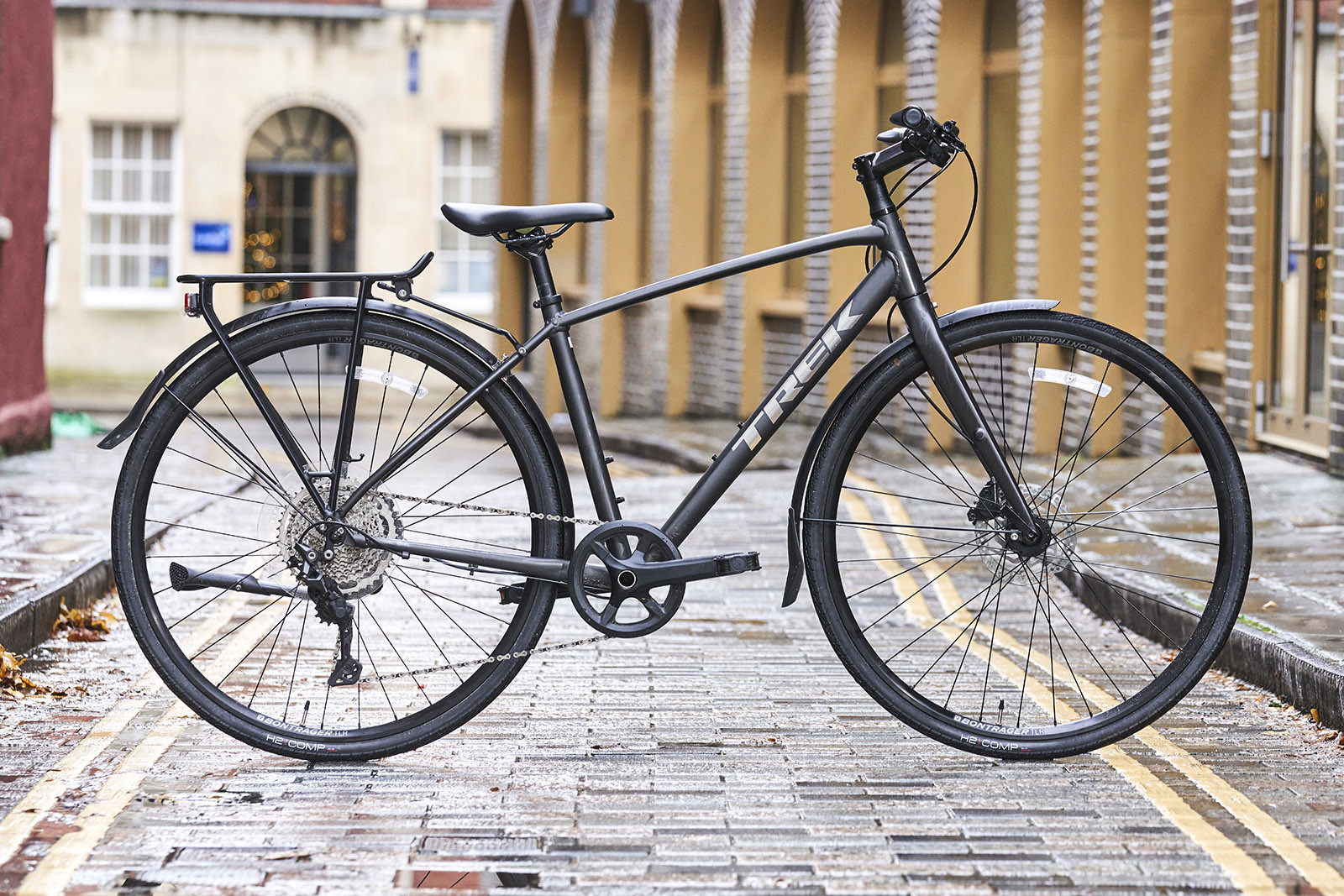A hybrid bike truly lives up to its name, blending the characteristics of road bikes and mountain bikes into a versatile machine. Imagine a bicycle designed for everyday riding across diverse terrains – that’s essentially what a hybrid bike offers. This adaptability is why they are a popular choice, particularly for commuting and general fitness riding.
Decoding the Hybrid: Road Bike, Mountain Bike, and Gravel Bike Comparisons
 Trek FX 3 Disc hybrid commuter bike featuring a 1x drivetrain, mudguards, and rear rack, showcasing typical hybrid bicycle features.
Trek FX 3 Disc hybrid commuter bike featuring a 1x drivetrain, mudguards, and rear rack, showcasing typical hybrid bicycle features.
One of the most distinguishing features of the best hybrid bikes is their flat handlebars. Unlike the drop bars found on road bikes, flat handlebars are borrowed from mountain bikes. This design choice directly influences the bike’s components. Shifting and braking systems on hybrids often mirror those found on mountain bikes, differing from the integrated brake and shift levers (STI-style) prevalent on road bikes.
This handlebar configuration encourages a more upright riding posture. Many riders find this position more comfortable and even safer, especially when navigating city traffic. While this upright stance might not be as aerodynamically efficient as the lower positions achievable on road or gravel bikes, it prioritizes comfort and visibility.
Hybrid bikes also prioritize rider comfort through their tyre selection. They typically feature tyres with a larger volume compared to the slender tyres of road bikes. This increased volume provides enhanced cushioning and shock absorption, resulting in a smoother ride, especially on less-than-perfect road surfaces. These tyres offer more comfort than dedicated road tyres, making hybrid bikes suitable for varied conditions.
The spectrum of hybrid bikes is broad. Some models lean towards their mountain bike origins, while others are closer relatives to road bikes. Wheel size often serves as a helpful indicator of a hybrid’s bias. Hybrids equipped with 26-inch wheels, a size commonly seen on mountain bikes, tend to be more oriented towards off-road capabilities. Conversely, those with road bike-style 700c wheels are generally better suited for paved surfaces and less demanding off-road excursions.
 Canyon Pathlite:ON 9 LTD SUV electric hybrid bike with suspension fork, illustrating a mountain bike-inspired hybrid design with electric assist.
Canyon Pathlite:ON 9 LTD SUV electric hybrid bike with suspension fork, illustrating a mountain bike-inspired hybrid design with electric assist.
Given their mixed DNA, hybrid bikes might seem similar to gravel bikes at first glance. However, the design philosophies diverge. Hybrid bikes are primarily engineered for practicality and rider comfort in everyday scenarios. Gravel bikes, in contrast, prioritize performance across varied terrains, often leaning towards faster riding and more adventurous routes. Gravel bikes are built for performance, while hybrids prioritize practicality.
Braking systems on hybrid bikes can vary, but disc brakes are a very common feature across the range. These offer reliable stopping power in various weather conditions. You’ll find both mechanical and hydraulic disc brake options available on different hybrid models.
Gear ranges on hybrids are typically generous, catering to varied terrains and rider fitness levels. Historically, triple cranksets were common on hybrids, providing a wide spread of gears. Modern hybrid bikes often simplify things with 1x drivetrains paired with wide-range cassettes. This setup offers ample gear choices while reducing complexity and maintenance. For riders seeking ultra-low maintenance, some hybrids even feature hub gears, while singlespeed models are available for those who value simplicity above all else.
Practicality is a key consideration in hybrid bike design. Many come equipped with essential accessories like full mudguards and pannier racks right from the factory. Even models that don’t include these as standard are typically designed with mounting points and sufficient frame clearance to easily add them later. This makes them highly adaptable for commuting, errands, and carrying gear.
Some hybrid bikes incorporate a suspension fork into their design. These are generally basic suspension units intended to enhance comfort on bumpy roads and light trails. However, it’s important to note that these forks offer limited performance for serious off-road mountain biking.
The hybrid category is also embracing electrification. A growing segment of electric hybrid bikes integrates battery-powered motors to provide pedal assistance. These e-hybrids expand the capabilities of hybrid bikes, making them suitable for longer commutes, tackling hills with ease, and carrying heavier loads.
In conclusion, the defining characteristic of a hybrid bike is its versatility. It’s designed to be a ‘jack of all trades,’ adept at various riding styles and terrains, although it might not be the absolute master of any single discipline. While a road bike will offer superior speed on paved roads and a mountain bike will excel on challenging trails, a hybrid bike strikes a balance. For individuals who enjoy riding across mixed terrains or prioritize comfort and practicality for everyday cycling, a hybrid bike presents itself as an ideal and adaptable choice.

